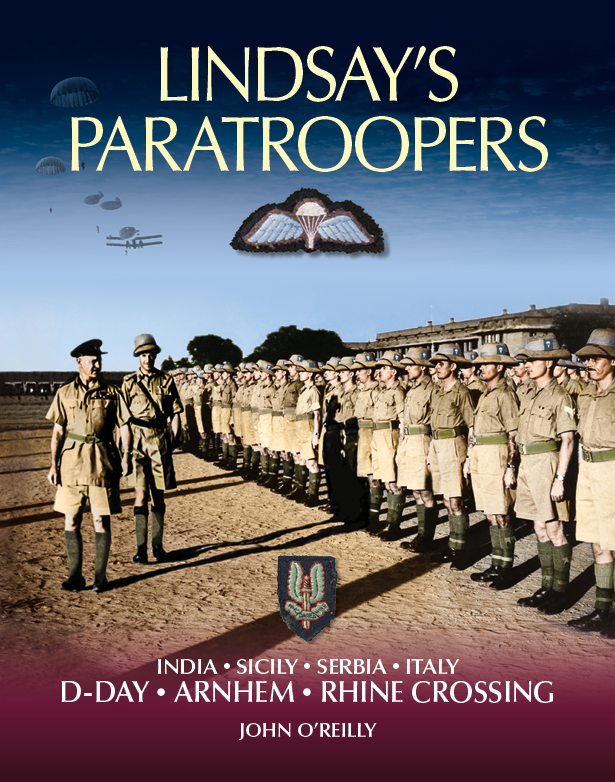New Book Special Offer - LINDSAY’S PARATROOPERS
New Book Special Offer - LINDSAY’S PARATROOPERS
Couldn't load pickup availability
We have been given the opportunity by our very good friend John O'Reilly to offer his latest book to our customers, We have a limited number available signed by the author.
LINDSAY’S PARATROOPERS
by John O’Reilly
A visit to see John Waddy, or Colonel John as he is affectionately known by those associated
with the 156 Family and The Arnhem Fellowship, was the catalyst for the writing of this
book. It was March 2020 when we called in to see Colonel John at his home in Somerset.
The hour we planned to spend with him turned into three as his captivating stories flowed.
Some we had heard many times before but there were also some new gems. Of course, he
would start those involving more colourful language with “For the ladies present, please
excuse my French.” He always had a smile on his face when telling these stories and had
such a way with him that he got away with it every time.
As we prepared to leave, Colonel John looked directly at me and said: “I wonder what
happened to our chaps that had to leave us in the Middle East after serving seven years
overseas? They were some of the best men we had in the Battalion.” He had said these same
words to me before but this time I felt it was a sort of veiled order. This would be our last
meeting. He was in his 100th year and perhaps he knew his time was nearly up. He passed
away in August.
At his funeral held in a small village church close to the Blackdown Hills, his nephew
brought along to the churchyard John’s favourite dog, a springer spaniel, which closely
resembled Gin, John’s spaniel throughout his time in India. The relevance was not lost on
those who knew him well. It had been raining but as six paratroopers carried him to his final
resting place and a bugler from The Parachute Regiment played the Last Post, the sun briefly
shone.
It was at that point in time that I decided to try to find out just what had happened to those
men sent home, not realising the incredible stories I would uncover. It has been a long
journey – four and a half years – and many of you in the 156 and Fellowship families, as
Colonel John liked to say, have helped contribute to its realisation. There was a time last year
when I thought I might never reach this point, hence the long delay. Finally, I can say it is
completed and virtually all of the men that John referred to have been traced. And what a
war they had.
Lindsay’s Paratroopers begins with the precarious development of early parachuting
experienced by Martin Lindsay. He played a critical role in establishing Airborne Forces at
Ringway in 1940 and, later – as their commanding officer – in the training of the 151 and 9th
parachute battalions for war.
In 1941, Lieutenant Colonel Lindsay was sent to India charged with raising and training the
151 Parachute Battalion for which he selected only the finest volunteers from the 27 British
regiments based there. He had an unconventional attitude to training, frequently taking his
own initiative to find innovative solutions to situations and was never afraid to challenge the
opinions of senior officers.
In March 1943, the 151 was re-badged 156 Parachute Battalion. At around the same time,
having served the maximum allowed seven years overseas (the PYTHON Scheme), 90 of the
151 men had to return to the UK where they joined units in the 6th Airborne Division.
Others transferred to the SAS and the highly secretive departments of the SOE and MI9.
We follow the exceptional achievements of this little-known band of brothers in Sicily, Italy
and Arnhem, along with the 9th Parachute Battalion on D-Day and the Rhine Crossing where,
between them, they spearhead these significant operations. Due to a twist in fate, Lindsay
would lead the 1st Gordon Highlanders – part of the 53rd Highland Division – on the Rhine
Crossing, an action which would bring together men from his two former parachute
battalions.
Post 1945, we see how two of Lindsay’s original officer recruits from India, who had
remained in the Army, shape the new SAS. In 1951, his former adjutant, George Lee,
became Colonel Commandant of the SAS Regiment and is credited with returning it to the
standard achieved in WWII. He subsequently lead his men into successful action in the
Malayan jungle. In 1964, Colonel John Waddy was appointed Colonel SAS and Commander
of the SAS Group where he did much to develop its new role for the post-colonial war
period; in particular, improving the difficult command structure.
Lindsay’s Paratroopers provides stories of courage both from Lindsay’s personal accounts of
parachuting and challenges of command, as well as from the reports of many of his men. It is
the sheer number of operations undertaken in the various theatres of war, combined with the
effectiveness of Lindsay’s men and others that fought alongside them, that make this book an
action-packed read. It has 464 pages, more than 500 photographs and over 50 full colour
maps, together with numerous illustrations and associated items.
Share


